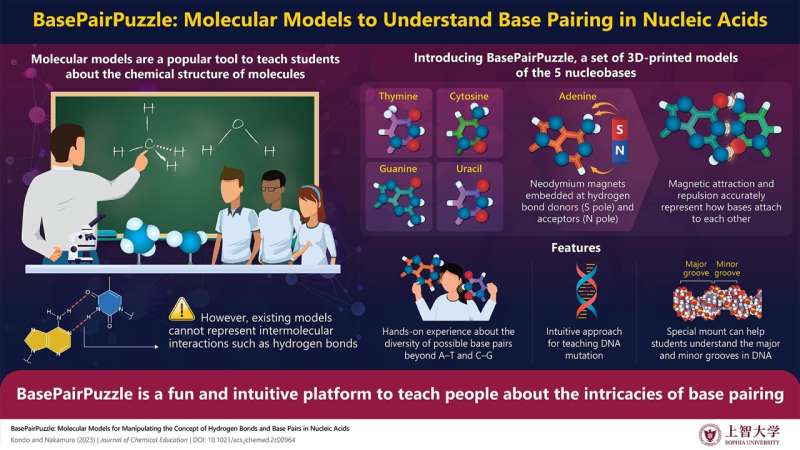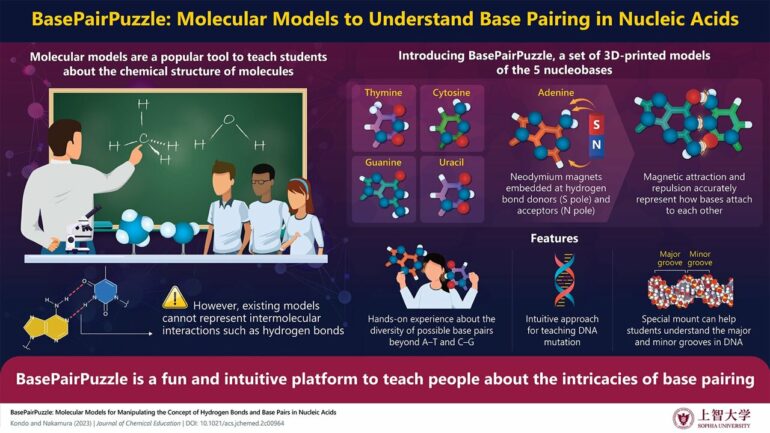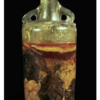Molecular models are a tried-and-tested tool for teaching chemistry to students of all ages. By enabling users to visualize the three-dimensional structure of a molecule and how its atoms are arranged, they can accelerate the learning process for essential topics such as covalent bonds. In biochemistry classes, molecular models of DNA are a popular way to teach students about nucleobase pairing and how the iconic double-stranded helical structure looks.
Despite their usefulness, most molecular models in the market have a notable limitation: they cannot represent intermolecular interactions. Hydrogen bonds, in particular, are a very important type of attractive force that forms between a hydrogen atom (donor) in one molecule and an acceptor site on the other, usually a nitrogen or oxygen atom. The strengths of these bonds vary with the distance and the angle between the acceptor and donor, making them challenging to depict using conventional molecular models.
Hydrogen bonds are among the main driving forces behind base pairing in DNA and RNA, and it would be better for students if there was a molecular model that could represent them more accurately. In response to this challenge, Associate Professor Jiro Kondo from Sophia University and Mr. Shota Nakamura from StudioMIDAS, both in Japan, designed BasePairPuzzle, a new type of DNA molecular model that accurately represents the phenomenon of base pairing.
The details and uses of this model are detailed in an article published online on January 26, 2023, in the Journal of Chemical Education.
At first sight, the pieces of BasePairPuzzle appear to be simple representations of the nucleobases A, C, G, T, and U. However, these 3D-printed parts have strategically placed crannies that can fit commercial, cylindrical neodymium magnets. The idea is that the repulsive and attractive forces between these magnets accurately mimic the hydrogen bonds and electrostatic forces that naturally exist between nucleobase pairs.

Using embedded magnets, this new molecular model accurately mimics hydrogen bonds and helps students understand the concept of base pairing, as well as other related topics such as DNA point mutations and the structure of the double helix. © Jiro Kondo from Sophia University, Japan
Thanks to its ingenious design, BasePairPuzzle allows students to not just see, but also feel how nucleobases pair with each other. “By designing the shape and size of the pieces to fit in the palm of the user’s hands, the right amount of magnetic force, and the clicking sound when hydrogen bonds are formed, the user can comfortably experience the sensation of molecules interacting with each other,” says Associate Professor Kondo.
While the puzzle is great for understanding why the complementary A–T and C–G pairs are by far the most common, it has the added benefit of allowing for non-complementary pairs to form. In turn, this makes it clear to students that there is great diversity in nucleobase pairs beyond the complementary ones, and that this diversity is what gives rise to the varied DNA and RNA structures that we now know exist.
In this regard, Associate Professor Kondo explains, “Once the students realize that the pieces are attracted to each other by magnetic forces, they will understand that any combination of the four bases will stick together in some way. The important thing to remember is that all of the combinations of bases the students make, even triplets and quartets, can exist in some RNA structures in living organisms, which means they are all correct.”
To top this off, BasePairPuzzle pieces can be mounted onto a special cylindrical mount to hold complementary base pairs and replicate the double-stranded helical structure of DNA. This lets students easily visualize the difference between the major and minor grooves. Another use for BasePairPuzzle is to illustrate how DNA mutations occur as an intuitive step-by-step process.
Associate Professor Kondo has already given many lectures and classes using BasePairPuzzle both in high school and university and has received lots of positive feedback from students. Moreover, the researchers have made the necessary files for 3D printing BasePairPuzzle pieces available to everyone free of charge, hoping to provide a hands-on experience of nucleobase pairing to as many students as possible.
More information:
Jiro Kondo et al, BasePairPuzzle: Molecular Models for Manipulating the Concept of Hydrogen Bonds and Base Pairs in Nucleic Acids, Journal of Chemical Education (2023). DOI: 10.1021/acs.jchemed.2c00964
Provided by
Sophia University
Citation:
A new 3D-printed molecular model to teach students about nucleobase pairing (2023, February 27)



